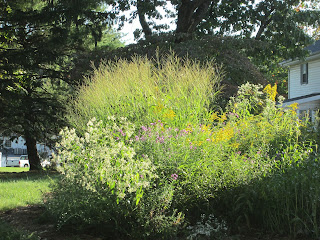These last few weeks have been (that overused but accurate word) intoxicating around here. My walk-and-sniff tours of the area began with the "Miss Kim" lilac in a neighbor's yard. The plant of course had to be visited every day. (And surely no one could object to someone stopping and enjoying a noseful of lilac.) Then came the discovery of the giant linden on Juliana Street, with its scent that always reminds me of long summer days with friends in Bulgaria. Since then, I have found two other lindens on streets in Marietta, and there are probably others waiting to be discovered.
Scent isn't reliable, which is part of its charm. Atmospheric conditions have to be right for scent to carry, and some plants need several hours of warmth before their floral aromas are noticeable. On warm afternoons, the lavender walk to our front door fills a large area with that distinctive scent, but early in the morning, the plants almost have to be brought to nose-level. This evening, the front-yard floral perfumes were too mixed for all the players to be identified: between the buddleia, the daisies, the santolina, the daylilies, the flowering thyme, and who knows what else, I just sat for a while and enjoyed.
Because this feast for the olfactory sense won't last. Of the plants currently casting their aromatic oils into the air, only the buddleia will continue for long. The others will be replaced by later-blooming delights, but the mix is never the same from one day to the next. We need to enjoy the scents of summer while they're with us.
Given that daylilies need to be deadheaded every evening, I am perfectly willing to bring some of the day's harvest of hemerocallis into the house to enjoy the blossoms' last few hours before they collapse. Who needs Glade air fresheners when these beauties are waiting outside the door?


























 Of course, meadow gardens are supposed to be wild, and I am still enjoying a long love affair with the native plants of our area. After all, what is there not to love about something as exuberantly gorgeous as butterfly weed, especially when it invites so many pollinators to the party, including lightning bugs?
Of course, meadow gardens are supposed to be wild, and I am still enjoying a long love affair with the native plants of our area. After all, what is there not to love about something as exuberantly gorgeous as butterfly weed, especially when it invites so many pollinators to the party, including lightning bugs?





